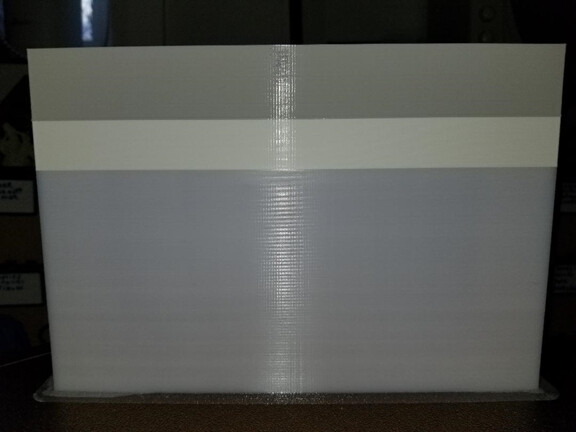So in the old topic (see old topic ) I was wondering if I could finish a PLA print with PETG is I run out of the former and only had the latter.
Well take a shuffty at this…

No it is not a marble layer cake! It is part of a game box insert for a certain game where you have to find cures for diseases as they spread accorss the planet.
Simply put’ I ran out of PETG at about 78% completion. It is quite a long print and I was not to keen about starting from scratch.
So I thought, what the hey, why not give it a try. So I took a leftover spool of PLA and it seemed to adhere quite well.
Then I ran out of white PLA and I said to myself : «Well, self, you were dumb enough to try and save time and money, might as well go all the way.» So I loaded the grey filament as seen in picture.
This is the finished product. It holds well, the only thing is, I had to appry two coats of paint (rattler can) to make the three layers disapear.
This project was cursed. While not a compex print I suffered two power failures and two filament run-outs, for a 24 hr 30 min print. Total time spent close to 30hrs. Sheesh!
1 Like
Yup. I had to do this. Only I was using the grey to represent stone/concrete. My original roll came from Amazon right after I received the printer. They ran out of stock and that’s how I discovered 3DPC but of course the greys don’t match.
There are thingies called colorimeters which measure color and brightness to assign a number to a given material’s colour. I realised this is a shortcoming in the 3D printing community - there’s no consistent method of identifying a filament’s colour, so how do you find the closest colour match if your original supplier runs out?
It turns out 3DPC has a colorimeter and I encouraged them to post the values for the various filaments they sell, but they’ve never done that.
I know they read these posts. Maybe they will pick up on that.
Lego,
Interesting idea. Output in degrees K would be useful. Although a densitometer would be more accurate. Hmmm I have a densitometer. I could easily print a flat disk sample and measure it. It reads RGB I wonder if it could be converted to rgb scale of 0-255 ?
Would that even be useful?
A colorimeter is apparently a sort of standard instrument in plastics manufacturing. It’s used for quality control and as such I would imagine almost all filament manufacturers would already have one, so you’d think they would just print the numbers on the label.
Of course, NOT printing the numbers on the label means that consumers have to keep buying from the same source over and over again if they need consistency which is really in the manufacturers favour, so I can sort of see why they don’t do it. For similar reasons, retailers would be disinclined to publish the numbers.
It’s really only the end-user that would benefit from it since it would empower us to shop around for colours that more closely match what we have in mind for a project.
For example, I’m looking around for a “Ryobi Green” to make a dashboard for my Ryobi mower, but of course, you’ll never find “Ryobi Green” listed anywhere, and Ryobi doesn’t sell filament.
Since it’s really only the consumer that benefits from this, I doubt we’re going to see it implemented any time soon.
1 Like
Being a photographer to me a color meter describes the color of light to adjust two different sources to the same. The densitometer measures the density of transmission of light or the volume of reflective light in rgb. The spectrometer is very similar but it measures the spectrum of reflected light.
It is a good idea but the values produced have little real world application. You are describing Pantone system where you get a set of insanely expensive swatches and the numbers they represent match a product plastic paint or ink.
Spool3d sells Pantone coded filaments. If you have a 500$ Pantone swatch book!
I have a couple of ryobi things I could measure it but as that is ½ the equation it is not very useful.
It is a good idea. If there was a good cheap easy method to index it.
Maybe companies should sell swatch sets of 10x10x3 mm bits of all the colors…
Or they could just tell us the actual numbers. It’s not like they’re hiding it from their competitors. Any plastics manufacturer would likely have one anyway and could just take their own measurements of a competitor’s products.
Personally, I wouldn’t care if the use the L.A.B. or R.G.B methods as long as it provides a method for the consumer to compare filament X to filament Y.
